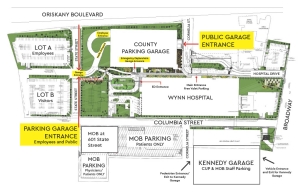Parking Information
Wynn Hospital, 111 Hospital Drive, Utica
The Wynn Hospital offers free valet parking from the main entrance for patients and visitors.
| Front Door Valet Parking Hours 5:30 a.m. to 8 p.m., weekdays 10 a.m. to 8 p.m., weekends |
A parking garage is also available immediately adjacent to the hospital (see maps below – click to enlarge). Public parking for patients and visitors is free for those coming to the Wynn Hospital and is available on the first and second floors of the garage. There is a separate garage entrance for Emergency Department (ED) parking directly off the ED circle.
A New Health Campus
Location: Downtown Utica
Hospital Size: The Wynn Hospital is 702,000 square feet (this includes the Central Utility Plant square footage)
Height: Ten stories (the top floor is for heating and air conditioning equipment).
Inpatient Unit: Total of 373 beds. Eight beds for Pediatric patients.
- Open-core nursing unit allows for close patient/staff adjacency, good staff visualization/connection to the patients on the floor and includes easy access to frequently used support functions.
- Each inpatient unit has 30 private rooms.
- Two rooms on each unit can be converted to semi-private as census levels increase.
- Same-handed rooms and standardized unit organization from nursing unit to nursing unit, which supports patient safety, reduces the risk of errors, provides greater efficiency and promotes same access points for staff when working in different areas.
- Dialysis support in each patient room for all Critical Care beds and isolation room beds. Reduces patient movement.
- Inpatient Dialysis Unit conveniently located on high-use, Intermediate Care floor and adjacent to patient elevators.
- Critical Care beds co-located on one floor to optimize use and flexibility with quick connections to and from the Emergency Department and Interventional areas such as Imaging.
Inpatient Views: Unobstructed north- and south-facing views for patients on inpatient floors.
Emergency Department (ED):
- Designed with 47 ED treatment spaces (ED exam, quick turn, trauma), six Behavioral Health ED treatment rooms and 10 Observation beds.
- Modular organization allowing efficient flexing to respond to changing volume needs over a typical day.
- Dedicated access to the Medical Imaging room and CAT Scan with direct and easy access to other imaging modalities.
- Sited and organized to allow for easy expansion opportunity to the west of the site.
- The new design will support the care of 90,000 visits annually.
Imaging/Cardiology:
- Centrally located with easy inpatient and outpatient access allows for efficient patient movement, staff support and connection to ED.
- Appropriate internal flows, adjacencies and segregations to provide for optimal use and safety.
Interventional Platform:
- Fully integrated Surgical Services, Interventional Services and Endoscopy Platform.
- Flexible perioperative area allowing easy changes to dynamically respond to case mix and pre/post procedure needs.
- Standardized modular design to allow for flexible use.
- Provision of “soft” spaces provided to allow for incremental expansion.
- Siting of perioperative and procedure space to allow for easy, long-term expansion to the west on the site.
Sammon Family Birthing Center:
- Quick-access elevator connection from Emergency Department which allows rapid movement for presenting mothers.
- Continuous flow from early labor/triage to Labor, Delivery and Recovery (LDR) or cesarean section (c-section) surgical suite.
- Direct connection from LDR to C-section suite.
- Easy flow from C-section suite to Special Care Nursery.
- Co-located Special Care Nursery and Nursery with direct access to Postpartum suite.
- Distinct Postpartum suite from delivery area provides a more relaxed environment for recovering mothers and family.
Building Circulation:
- One primary entrance into facility with easy drop-off, garage parking and building entry connections.
- Separate emergency walk-in, ambulance and decontamination entrances.
- On-stage/off-stage building organization aiding in wayfinding, security controls and supporting patient dignity.
- Separate patient, service and visitor elevator cores providing for safe, efficient movements that help ease patient, staff and family stress.
- Dedicated, rapid-access elevator pulled from general use for quick movement of patients from ED to Intervention, ED to Birthing Center, ED to Behavioral Health, inpatient connection to intervention. Elevator sized to accommodate patient plus team and necessary patient transit equipment.
- Dedicated supply and food elevators; these will be used for all deliveries and will be separate from patient and visitor elevators.
- Service flows separated on lower, heavy-use floors considering dirty/clean flows.
Conference/Meeting Spaces:
- Located on edges of departments to allow for shared use.
- Main education/auditorium rooms located near building entry and Nutrition to allow for multiple meeting formats, easy staff access and convenient community use for wellness and other programs.
Nutrition:
- Room service model to be incorporated with quick turn-around times enhanced by adjacency to dedicated food/medication elevator.
- Easy cafeteria access for visitors and staff with location off of main lobby by visitor elevators.
- Adjacency to Education Center allows for efficient support of meetings and functions.
- Easy access to loading dock area for deliveries of hospital supplies.
Parking Garage:
- Partnership with Oneida County.
- Access to parking garage at multiple points to make it convenient for patients, families and visitors.
- Parking for hospital patients and visitors, staff, volunteers as well as the community for non-hospital related events.
Campus:
- Pedestrian-oriented.
- Designed as an urban park with enhanced lighting, trees, flowers, walkways and seating areas.
Helistop:
- Conveniently located on top of the attached parking garage.



